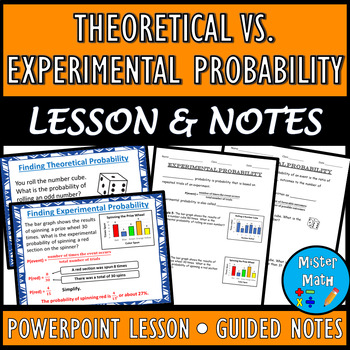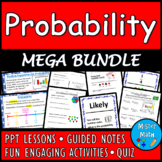Theoretical vs. Experimental Probability PPT & Guided Notes BUNDLE
- Zip
- Easel Activity
Products in this Bundle (2)
Also included in
- This Probability MEGA BUNDLE is just what you've been looking for to assist students in learning about likelihood, simple probability, and experimental/theoretical probability! Included in this bundle, you will find:Outcomes & Events PowerPoint LessonOutcomes & Events Guided Notes (coincidesPrice $15.99Original Price $29.70Save $13.71
Description
This BUNDLE includes a PowerPoint Lesson and a corresponding Guided Notes Packet to assist students in learning about theoretical and experimental probability. Students will learn the concepts of theoretical and experimental probability, as well as how to find the probabilities of each. Plenty of real-life examples are included to give students ample opportunities to practice the skills. Overall, the 21-slide PowerPoint and 6-page guided notes packet covers the following topics:
- Theoretical Probability
- Using Theoretical Probability
- Experimental Probability
- Making Predictions
- Comparing Theoretical & Experimental Probability
The presentation also comes fully animated, with animations triggered by mouse click (or presentation pointer)! An answer key is provided for the guided notes packet, as well.
You'll SAVE MONEY when you purchase these resources with this BUNDLE!
Want to learn more about what's included in this bundle? Click the links above to get more information about each included resource!
********************************************************************************************************
Thank you so much for visiting my store! If you want to stay up-to-date on new products and sales, please click on the green ★ next to my name to follow my store!
☆ If you enjoyed this product, please leave a rating and some feedback! ☆
By leaving feedback, you can also earn TpT credits that can be applied to future purchases to save you money!!
********************************************************************************************************
Connect with me!
********************************************************************************************************
You might also be interested in:
Probability PPT & Guided Notes BUNDLE
Outcomes & Events (Probability) PowerPoint Lesson
Outcomes & Events (Probability) Guided Notes
Outcomes & Events (Probability) PowerPoint and Guided Notes BUNDLE
Playing Cards Probability Activity
Number Cube Probability Activity
Theoretical vs. Experimental Probability PowerPoint Lesson
Theoretical vs. Experimental Probability Guided Notes
Theoretical vs. Experimental Probability Riddle Activity
Theoretical vs. Experimental Probability Scavenger Hunt
One-Step Addition & Subtraction Equations MEGA BUNDLE
One-Step Multiplication & Division Equations MEGA BUNDLE
Adding Integers (Using Manipulatives & Number Lines) PPT and Guided Notes BUNDLE
Adding Integers (Using Rules) PowerPoint Lesson
Adding Integers (Using Rules) Guided Notes
Subtracting Integers PowerPoint & Guided Notes BUNDLE
********************************************************************************************************
© Copyright 2021 Mister Math, ALL RIGHTS RESERVED. Permission is granted to copy pages specifically designed for student and/or teacher use by the original purchaser or licensee ONLY. You may not share the activities with anyone else unless additional licenses are purchased. Reproducing, copying, editing, distributing, selling, or placing any part of this product on the Internet is strictly prohibited. Doing so is a violation of the Digital Millennium Copyright Act (DMCA).



